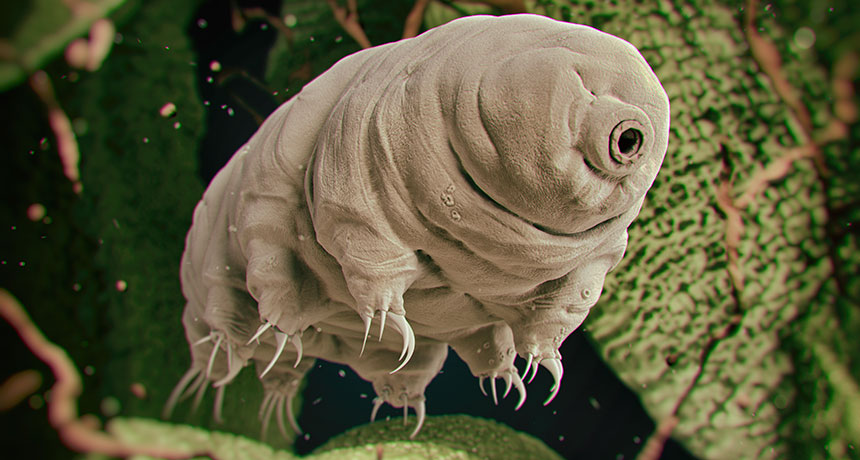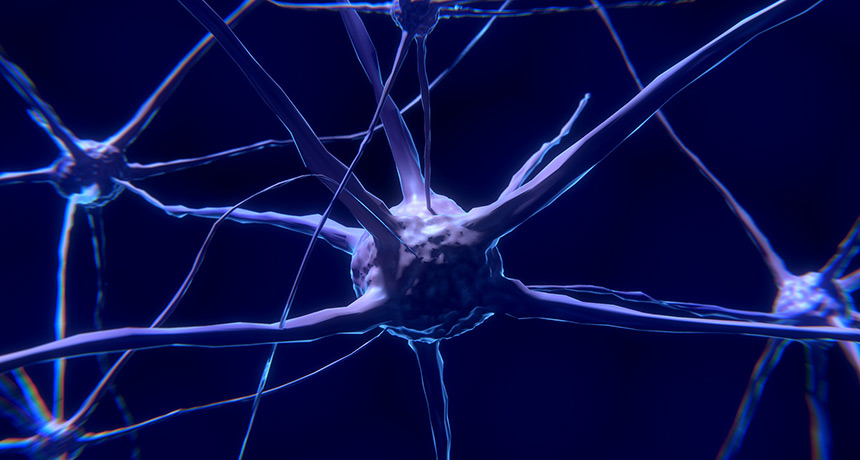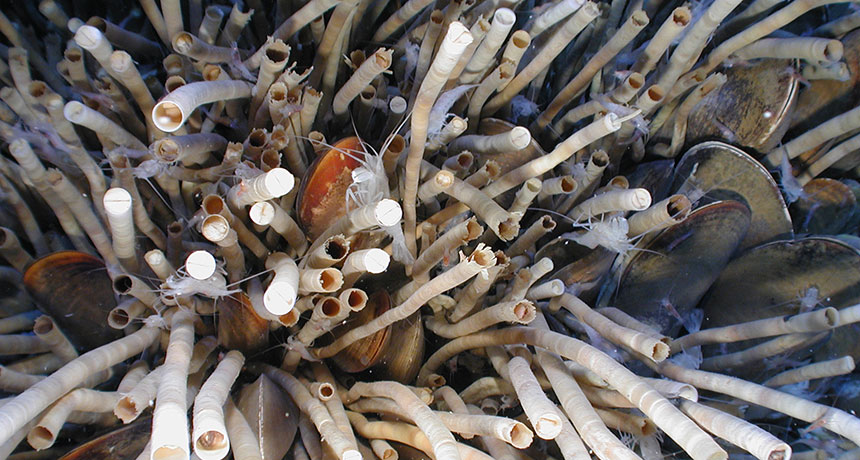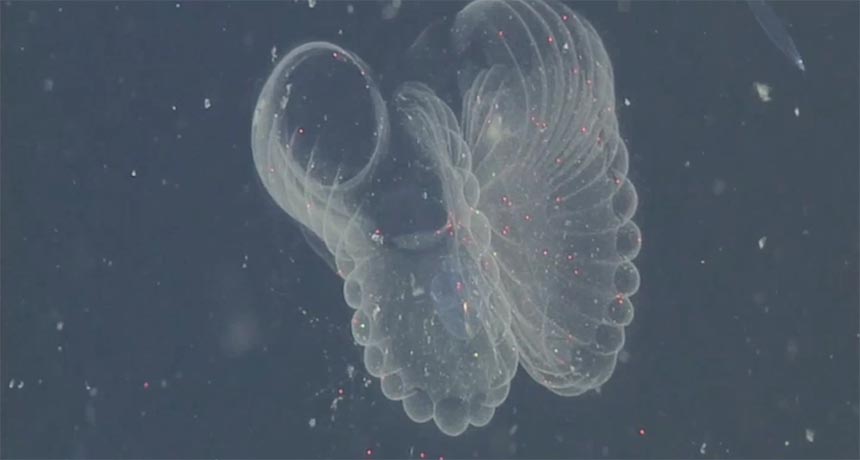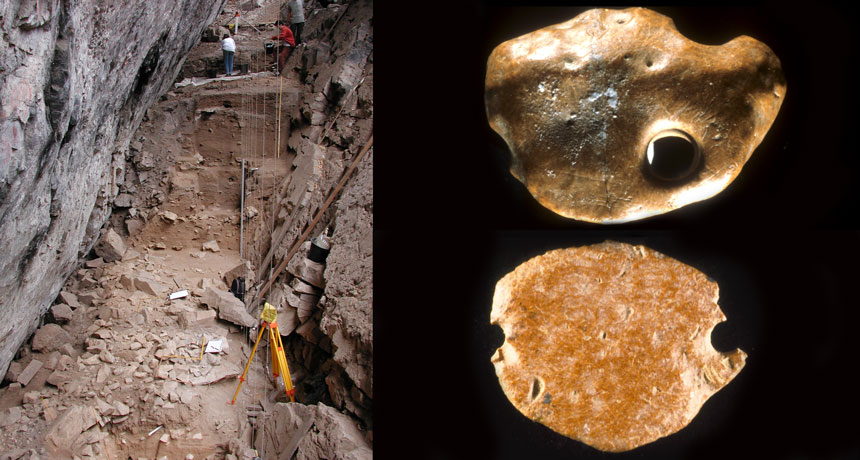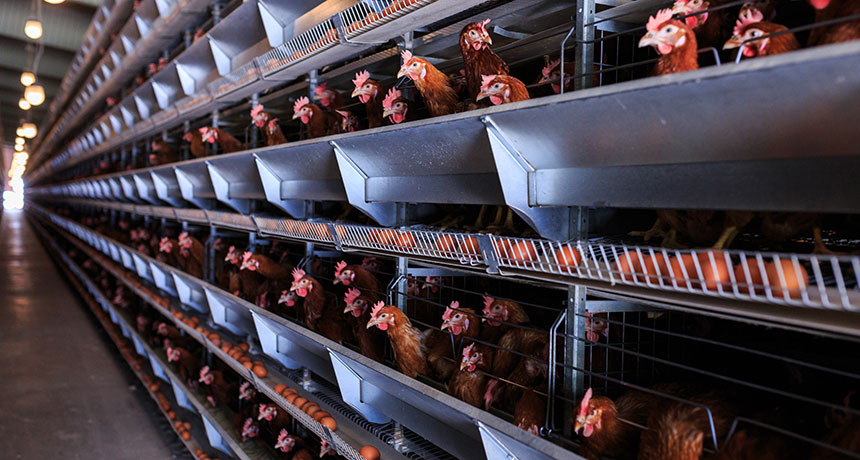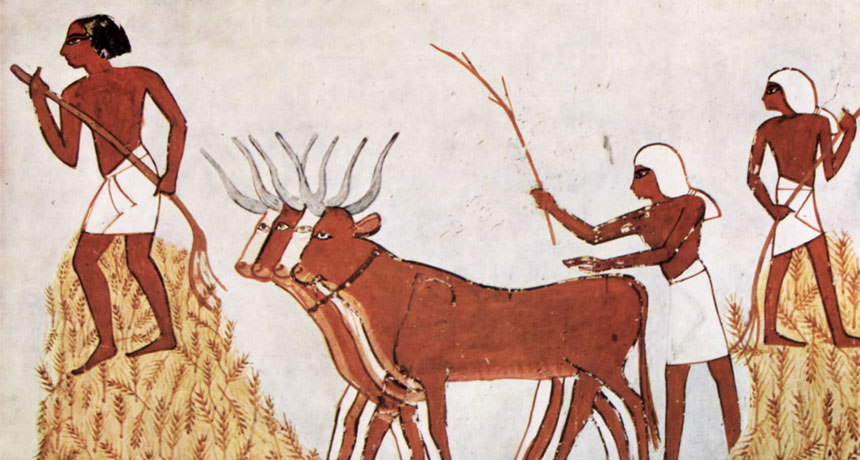DNA evidence is rewriting domestication origin stories
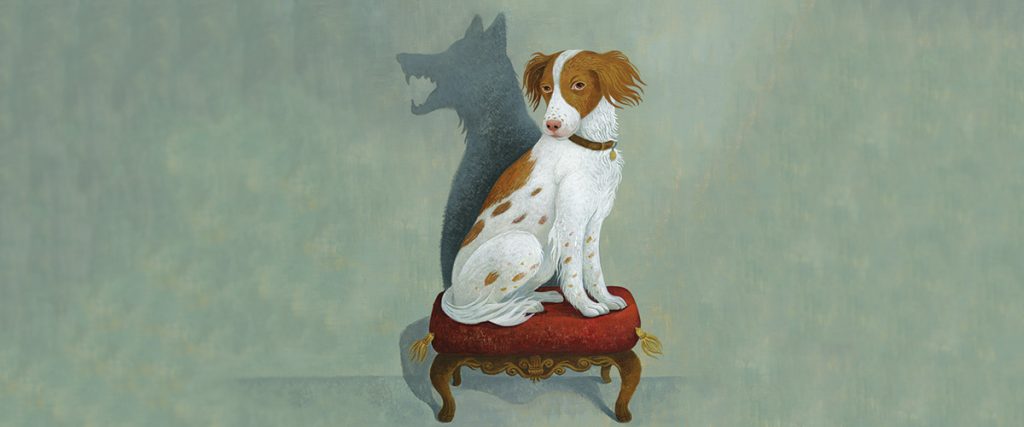
One lab full of rats looks pretty much the same as another. But visiting a lab in Siberia, geneticist Alex Cagan can distinguish rats bred to be tame from those bred to be aggressive as soon as he opens the lab door.
“It’s a completely different response immediately,” he says. All of the tame rats “come to the front of the cage very inquisitively.” The aggressive rats scurry to the backs of their cages to hide. Exactly how 70 generations of breeding have ingrained friendly or hostile behaviors in the rats’ DNA is a mystery that domestication researchers are trying to solve. The rats, along with mink and silver foxes, are part of a long-running study at the Institute of Cytology and Genetics in Novosibirsk, Russia. The aim is to replay domestication to determine the genetic underpinnings that set domesticated animals apart from their wild ancestors.
For thousands of years, humans have lived with animals. Some of the creatures are companions — hopping onto laps, ready to play fetch. Some have jobs — carrying heavy loads, pulling wagons and plows, and herding other animals. Others provide meat, eggs or milk. Plants, too, have been tamed. On nearly every continent, fruits, vegetables, grains, nuts and tubers stand in soldier-straight rows and yield bounty on schedule.
There was a time when the species that now inhabit humans’ homes, fields and barnyards didn’t exist. Then some people, somewhere, brought wild things under human control. Or the wild creatures exploited new ecological niches created by humans, gradually habituating themselves to people and, in essence, domesticating themselves. Both paths — scientists are still debating which was more likely for different animals — led to the creation of domesticated species or subspecies genetically distinct from their wild ancestors.
Scientists studying evolution and human history want to know how ancient people domesticated animals and plants. What species did humans start with and where did it happen first? How long did it take? Does one group get credit for taming wild horses or subjugating aurochs into milk-giving cows? Or did multiple people in different places have the same idea?
Even for dogs, humans’ oldest, closest friends, “all those things are unknown,” says evolutionary geneticist Greger Larson of the University of Oxford. For many domesticated creatures, the questions outweigh the answers. As new studies flood in — some based on archaeology, others on modern or ancient DNA — the waters get muddy, with one study’s results contradicting another’s.
“Domestication research right now is really going through an exciting phase,” Larson says. Comparing the genetic instruction books, or genomes, of wild and domesticated species is giving evolutionary geneticists fresh clues about the changes that separate domesticated species from wild ones. New techniques (some developed in the last two to three years) for analyzing fragile DNA from ancient bones offer genetic snapshots of domestication as it played out long ago. Marrying that DNA data with archaeological findings, the context in which the bones were discovered, for example, may tell researchers more about when, where and how humans first engaged with plants and animals. Recent results are already rewriting the stories of rice, horse and chicken domestication.
A new hypothesis is also shining a light on core changes in the embryos of many domesticated species. The hypothesis aims to explain how the process of becoming close to people produces comparable changes in the appearance, reproduction and physiology of a whole range of domesticated animals. One central developmental change — in a temporary clump of cells called the neural crest — may be behind the suite of characteristics known as domestication syndrome.
The pace of research, much of it seemingly contradictory, will only increase in the near future, Larson predicts. “We’re going to get a lot more confused before we figure out what’s really going on.”
Defining domestication
Deciding when an animal can be called “domesticated” isn’t always easy.
Since 2002, Anna Kukekova has been making annual treks to Novosibirsk. A geneticist at the University of Illinois at Urbana-Champaign, she travels to Siberia each year to collect blood from hundreds of silver foxes to look for genetic changes that produce tame and aggressive behaviors.
These foxes are special. They are part of a long-running biological experiment to repeat domestication by turning a wild canid — from the family of animals including wolves, foxes, jackals and dogs — into a fox version of a domestic dog (SN: 5/13/17, p. 29). The project was the brainchild of geneticist Dmitry Belyaev. In the 1950s, Belyaev and colleagues started selecting and breeding the least aggressive and fearful silver foxes from those on a fur farm. Since 1960, researcher Lyudmila Trut and her team have selected the farm’s friendliest foxes to breed. Over more than 60 generations, the foxes have grown more and more tolerant of humans. Kukekova says she’s noticed a difference even in the 15 years she’s been visiting the farm.
In Kukekova’s early visits, about 70 percent of the tame foxes were considered “elite,” aquiver with excitement when people came around. The rest of the tame ones “didn’t mind if you petted them, but they weren’t super excited to interact with you,” she says. Now, almost every tame fox is in the super-friendly elite group. (Foxes bred to be aggressive, on the other hand, are definitely not happy to have people around, much like the fearful rats Cagan encountered at the institute.)
Even though the friendly Novosibirsk foxes are genetically tame — some are sold as pets — not everyone would call the animals domesticated. “In an apartment, they would probably be very difficult pets,” Kukekova says. The foxes have a strong odor, are more active at night and they aren’t easily house-trained. The combination of living with people plus inherited changes in the foxes’ genomes may eventually make them fully domesticated, but they aren’t there yet.
Researchers have set out several biological criteria that should determine when silver foxes, or other animals, cross the line that divides merely tame from fully domesticated. Number one: Domesticated animals are genetically distinct from their wild forebears, and they inherit their human-friendly demeanor. That’s different from wild animals that have been tamed but don’t pass on that tameness to the next generation.
Two: Domestication makes animals dependent on humans for food and, for the most part, reproduction. Three: Breeding with wild counterparts becomes difficult, if not impossible. For example, domesticated plants don’t drop their seeds when ripe; they rely on humans to spread their progeny. Finally, domesticated animals and plants should bear the physical hallmarks of domestication syndrome, such as a smaller skull for animals, and a narrower footprint for plants.
By these criteria, some people argue that cats — popular pets worldwide — are not fully domesticated. Cats probably started taming themselves about 9,500 years ago by hunting vermin, infesting early farmers’ grain stores and feasting on food scraps. Farmers brought the mousers with them from the Middle East into Europe around 6,400 years ago, researchers reported June 19 in Nature Ecology & Evolution (SN Online: 06/19/17). But cats may not have been purring lap pets at that time, say molecular biologists Thierry Grange and Eva-Maria Geigl of the Institute Jacques Monod in Paris. That behavioral transformation may have happened later, perhaps in Egyptian cats that were quickly dispersed by boat around the ancient world.
In fact, cats haven’t changed much physically or genetically from their African wildcat ancestors (Felis silvestris lybica), Grange and Geigl say. Many felines still choose their own mates and hunt for food. Cats’ famed aloofness may be another clue that their domestication isn’t fully complete. Certainly, cats are more like their wild ancestors than dogs are, says Grange. But modern kitties are no longer wild cats, Geigl argues: “These couch potatoes are domesticated.”
Relationship status
Bonds between humans and their animal companions may be more important than rigid biological criteria, Larson and other researchers argue. Domestication, says zooarchaeologist Alan Outram of the University of Exeter in England, “is best looked at with a more cultural definition.”
Domestication is a gray area encompassing the point at which a hunter stops being interested in simply killing and eating an animal and starts being interested in controlling the animal, Outram says. The process probably starts slowly, first with animal herding and other forms of husbandry, such as controlling an animal’s food supply and movement, culling at specific ages and directing breeding. When people start using animals, such as horses, for labor, riding or milking (fermented horse milk is a staple in parts of Central Asia), the animals “start moving to being culturally domestic,” he says.
Outram has evidence that the Botai people, hunter-gatherers that lived in Central Asia, were milking and bridling horses about 5,500 years ago (SN: 3/28/09, p. 15). “I certainly wouldn’t want to make the argument that at the Botai time you’ve got anything like modern domesticated horses,” he says. It was “more like equine husbandry and herding.”
Scientists have to be careful not to judge how domestication happened in the past by the way animals are treated in modern Western cultures, says evolutionary biologist Ludovic Orlando of the University of Copenhagen. On a trip to collect DNA samples from ancient horse bones in Mongolia, Orlando got a whole new perspective on domestication.
“It completely changed my view of horse domestication, because I saw people interacting with this animal in ways I couldn’t imagine myself,” Orlando says. In Mongolia, horses roam free and their owners catch them, as needed, for riding or milking. “Once you’ve seen that, you can’t think that domestication is just about parking animals somewhere. It’s about the process of interacting with them and developing a relationship with them.”
Dog days
If it’s hard to pinpoint what domestication means in foxes tamed in controlled experiments, consider how difficult it is to decide whether the bones of a long-dead animal are from a wild or domesticated critter. That’s the task of paleontologist Mietje Germonpré of the Royal Belgian Institute of Natural Sciences in Brussels, who studies dog domestication. The beloved pets are the subjects of much domestication research.
Scientists used to think that dogs were domesticated toward the end of the Ice Age, about 14,000 years ago (SN Online: 7/22/10). Germonpré and colleagues have studied skulls and jawbones of even more ancient canids in caves and other places where Ice Age people lived more than 25,000 years ago. One skull, found in a Goyet cave in Belgium, may be one of the oldest dogs ever discovered — or at least the oldest wolf that looked like a dog. At 36,000 years old, the Goyet pooch pushed dog domestication back to well before glaciers reached their peak coverage of the Northern Hemisphere.
Those early dogs may have been used as pack animals to move mammoth carcasses from hunting grounds to living quarters, says Germonpré. Big dogs may have helped humans hunt dangerous carnivores, such as cave bears, hyenas and cave lions. It’s also possible the animals were used for fur or meat.
Germonpré’s assertion that the Goyet dog is in fact a dog comes from comparing its skull and jaws with those of wolves and modern dogs. Most domesticated mammals, including dogs, tend to have smaller bodies than their wild counterparts, with smaller skulls that have shorter, wider snouts and shorter, lower jaws. Those features make adult dogs look more puppylike than grown wolves do. That type of facial remodeling is part of the domestication syndrome, which also includes curly tails, floppy ears and other characteristics common among domesticated animals but not wild ones. By Germonpré’s measurements, the Goyet skull more closely resembles modern dogs than it does ancient or modern wolves.
She also has evidence of early dogs in Russia and the Czech Republic dating to 25,000 years ago or more. Other groups have reported data suggesting that a 33,000-year-old canid from the Altai Mountains of Russia was also an early dog.
Other researchers disagree, saying the animals were really wolves. Three-dimensional reconstructions of the skulls of the Goyet dog and another Ice Age dog show that the animals’ snouts didn’t angle from the skull the way modern dogs’ do, and the ancient versions didn’t have some other features of modern dogs (SN Online: 2/5/15).
Larson says he’s not bothered that the Goyet hound didn’t physically measure up in the 3-D study. The canid may have behaved very much like a dog and had close ties to humans. Those early dogs didn’t have thousands of years of intense breeding selection to sculpt them into the image of modern dogs. Even modern dogs have been transformed dramatically in just 200 to 300 years of breeding (SN Online: 4/26/17; SN: 1/31/09, p. 26). “What was a dog 15,000 to 30,000 years ago is not what a dog is now,” Larson says.
The timing of Fido’s taming isn’t the only dispute. Researchers also wrangle over where and how many times it happened. Dueling genetic studies based on the DNA of modern dogs and wolves suggest the fellowship between humans and dogs could have been forged in the Middle East, Central Asia, East Asia or, as Goyet’s archaeological evidence suggests, in Europe. Research reported by Larson and colleagues last year in Science suggests that dog domestication happened at least twice, once in Europe and once in East Asia (SN: 7/9/16, p. 15).
DNA evidence indicates that the Goyet dog and the 33,000-year-old Russian dog are not the ancestors of today’s dogs or wolves (SN: 12/14/13, p. 6). Scientists examined mitochondrial DNA, which is passed from mothers to offspring, to trace maternal lineages of ancient and modern dogs and wolves. The mitochondrial DNA of the Goyet and Russian dogs belongs to a maternal lineage that didn’t leave any modern descendants, researchers reported in Science in 2013. But it doesn’t mean the animals weren’t on the way toward being domesticated, Germonpré says.
Perhaps those dogs were part of an early, failed attempt at domestication, she says. “The domesticated animals became extinct, and domestication started up again somewhere else.”
Rice story shattered
Locating the cradle of most species’ domestication is difficult. Many were domesticated before writing was even invented. So scientists have to extract the story from artifacts and bones or from DNA.
The origin of Asian rice has been hotly debated for many years. Scientists used to think modern rice, Oryza sativa, was domesticated twice: sticky, short-grained japonica rice was domesticated in China, and in India, rice was domesticated into long-grained varieties indica and aus. Archaeological finds suggest that rice cultivation started about 9,000 years ago in China and 8,000 years ago in India. But true domestication probably happened only once — in China, says Dorian Fuller, an archaeobotanist at University College London.
People were certainly cultivating rice in India, but that’s just one step in the domestication process. The final threshold that separates a fully domesticated crop from a cultivated one is that domesticated plants require human intervention to spread their seeds, Fuller says. Wild grains, for instance, “shatter” their seed heads when ripe. But domesticated grains, including rice, wheat, barley, sorghum and millet, have mutations that prevent shattering. The only way the grain crops can propagate is if humans collect and plant the seeds.
It may have taken nearly 2,000 years for people in China’s Yangtze River basin to wrest complete control over rice, researchers reported last year in Scientific Reports. Scientists examined rice fossils to determine how easily the plant shattered its seed. Although people were growing an early rice 9,000 to 8,400 years ago, about 60 percent of plants were still dispersing seeds via shattering. It wasn’t until about 7,000 to 6,500 years ago that nonshattering rice began to edge out shattering varieties.
By examining DNA from modern rice strains, Fuller and evolutionary geneticist Michael Purugganan of New York University think they’ve pieced together the rest of the rice domestication story. DNA evidence clearly shows that China’s wild O. rufipogon was domesticated into O. sativa japonica. Traders carried domesticated japonica from China to India, where it was bred with the cultivated rice species O. nivara to produce domesticated aus about 4,000 years ago, Fuller, Purugganan and colleagues reported in January in Molecular Biology and Evolution. Indica’s story is less clear because its cultivated predecessor in India is still unknown. But the genetic evidence indicates that it got its domestication genes from China’s japonica.
Tails (and feathers) from the past
Working out the step-by-step history of domesticated animals is just as complicated. Until recently, researchers compared DNA from modern domestic animals with that of wild relatives, preferably the wild species that gave rise to the domesticated species. Sometimes that’s impossible to do. There are no wild cattle, for instance. Aurochs — massive cattle that eventually gave rise to domesticated cows — went extinct when the last one died in 1627 in Poland’s Jaktorów Forest.
Horses’ wild ancestors are also extinct, but remains from the warrior steeds of Genghis Khan and medieval knights, the Romans’ chariot horses and the mounts of the ancient Scythians, Greeks and Persians might fill in gaps in horse history and prehistory. Through the Pegasus project, begun in 2015, Orlando and colleagues have collected ancient DNA from horse fossils from a wide variety of time periods and cultures. “We’re looking at every possible ancient equine culture on the planet,” Orlando says.
Before the project, scientists mostly had to rely on DNA from modern horses to piece together the story of how the beasts of burden were domesticated. Findings of those studies may be misleading, Orlando and colleagues have concluded. For instance, studies of modern horses’ mitochondrial DNA plus Y chromosomes (passed from fathers to sons) told a nice, neat story: At the beginning of horse domestication, people must have captured just a few stallions and bred those stallions to many different mares.
But when Orlando and colleagues examined DNA of ancient horses, they found that the story started completely differently. Domesticated horses living 2,300 to 2,700 years ago — about the midpoint of horse domestication — had a wide variety of Y chromosomes, the researchers reported April 28 in Science (SN: 5/27/17, p. 10). That means many stallions contributed DNA to horses’ gene pool for at least the first few thousand years of domestication. It wasn’t until sometime after 2,300 years ago that people started winnowing down the number of stallions that were allowed to breed. Orlando doesn’t know yet when most Y chromosomes were lost.
The story of chicken domestication is being retold as well, also thanks to DNA evidence. Modern chickens carry a version of the thyroid-stimulating hormone receptor gene, TSHR, that has been linked to several domesticated chicken characteristics: year-round egg laying, faster egg production at sexual maturity, reduced aggression toward other chickens and less fear of people. Because that version of the gene is ubiquitous in present-day chickens and is responsible for those attractive traits, researchers thought that people probably selected the most prolific egg layers right from the very beginning, about 4,000 years ago. Picking better laying hens would also mean unwittingly choosing the domesticated version of TSHR.
But, the egg-laying version of the gene didn’t become popular among chickens in Europe until about A.D. 920, around the time that Christians started giving up meat on fasting days in favor of fish and fowl, Larson and colleagues reported May 2 in Molecular Biology and Evolution. (Rabbit domestication followed a religious proclamation, as well. In 600, Pope Gregory I declared that fetal rabbits, called laurices, are aquatic, which made them fish, suitable to eat during Lent. Rabbit breeding took off in monasteries in southern France, and bunnies quickly became domesticated.)
If Larson’s calculations are correct, egg laying wasn’t the main criterion for selecting which chickens to keep until the Middle Ages. By that time, the birds had been domesticated for thousands of years. So what were ancient people looking for when striking up friendships with the feathered animals — or any other creatures? Many people think it was about the relationship; tameness and docility were the most attractive qualities in potential animal pals. It’s hard to be buddies with a creature that constantly runs from you, or worse, attacks.
Docility makeover
A breeding experiment with wild red jungle fowl, the precursor to the domesticated chicken, may help explain whether selecting for tameness is the triggering event of domestication and all its characteristics. Behavioral geneticist Per Jensen of Linköping University in Sweden is in the middle of a domestication redo. He and colleagues have bred eight generations of the rust-feathered birds. Like the rats, mink and foxes in Novosibirsk, Jensen’s jungle fowl are bred to be more (or less) fearful of humans than their ancestors were.
From the beginning, the researchers took great pains to select birds only for their behavior: Jungle fowl were tested for tameness at 12 weeks old, before they reached sexual maturity. One researcher would approach the fowl and attempt to touch it, while an outside observer scored the bird’s reaction. Neither researcher knew whether they were testing a jungle fowl from the tame or fearful line.
“Mind you, this went well for two or three generations but then the difference started to be so big it was difficult to keep a secret,” Jensen says. After that, the tame birds were so calm they didn’t react when a human entered the room. “You basically had to kick them out of your way,” he jokes. By the sixth generation, tame birds were bigger and had a higher metabolism than their fearful counterparts, Jensen and colleagues reported in Biology Letters in 2015. Changes in body size, reproduction and metabolism happened quickly, even though the researchers were only choosing birds for tameness.
The tame birds, Jensen says, “show a lot of traits that you really associate with domesticated animals, but I’m not sure anyone would accept that,” he says. Becoming what other people think of as domesticated chickens may take more time: jungle fowl hens that lay eggs year-round and are big enough to eat. “I don’t think we’re talking about hundreds of generations, maybe dozens. It’s a much faster process than we used to think.”
Again and again, animals of various species domesticated at different times in different parts of the world develop the same domestication syndrome characteristics: more extensive breeding periods; smaller brains, hearts and teeth; small or floppy ears; spotted coats; curly hair and tails; variable numbers of vertebrae in the spine; and juvenile faces with shorter snouts. Researchers have found evidence that pigmentation genes differ between domestic and wild animals. Others have pinpointed changes in brain chemistry or genes involved in face development that may separate tame and wild animals. But scientists didn’t have a unifying explanation for why the physical traits of domestication syndrome were linked to tameness until three years ago.
That’s when geneticist Adam Wilkins of Humboldt University of Berlin, primatologist Richard Wrangham of Harvard University and evolutionary biologist and cognitive scientist W. Tecumseh Fitch of the University of Vienna introduced a new hypothesis. Selecting animals for tameness, they said, could alter genes that control a group of developmentally important cells called neural crest cells. Those embryonic cells migrate in the embryo and contribute to tissues involved in the fight-or-flight response, facial development and coloring.
Choosing animals for tameness might be selecting for ones that have changes in how their neural crest cells function, the researchers proposed in Genetics in 2014 (SN: 8/23/14, p. 7). Calmer domesticated animals might have neural crest cells that move or work differently than the cells in more fearful wild animals. Because neural crest cells contribute to so many tissues in the body, altering their function could change an animal’s behavior, appearance and biology, the researchers reasoned. For the first time, domestication researchers had a hypothesis about the link between tameness and physical traits that could really be put to the scientific test.
Since the neural crest hypothesis surfaced, geneticists have found tantalizing clues that Wilkins, Wrangham and Fitch are onto something. Analysis of cat DNA found that house cats and wild cats have different versions of genes implicated in neural crest cell migration (SN: 12/13/14, p. 7). When Orlando and colleagues examined horse DNA for genes that may have rapidly changed during domestication, they too found genes involved in neural crest cell function.
While at the Max Planck Institute for Evolutionary Anthropology in Leipzig, Germany, Cagan compared DNA from the tame rats and mink at Novosibirsk, and from other domesticated species, with DNA from aggressive counterparts and wild ancestors. In unpublished research, Cagan (now at the Wellcome Trust Sanger Institute in Hinxton, England) found that genes involved in helping neural crest cells migrate differed between the tame and wild animals (SN: 6/13/15, p. 11). That might explain the white patches of fur, shorter snouts and curly tails of the tame animals.
Jensen calls the neural crest cell hypothesis “a very speculative idea that may not be applicable across species.” He is looking more closely at the neural crest in the jungle fowl. He and colleagues are collecting eggs to track the cells’ movements in tame and fearful birds. Even if the researchers find differences, he says, “we still need to find the genetic mechanisms that are causing the neural crest cells to act as they do.”
Larson expects many revelations in the next year or two about when, where and how domestication happened. “Even the big themes are going to be radically revised,” he says. Domestication is likely to be a far more complicated process than researchers expected, but Larson hopes people will find it all the more interesting for its lack of simplicity. “We want to get people to embrace the ambiguity and to love the complexity.”
